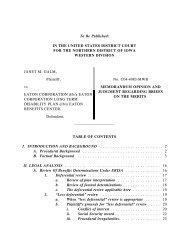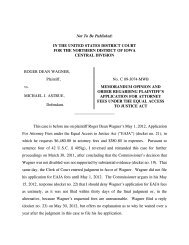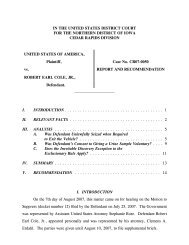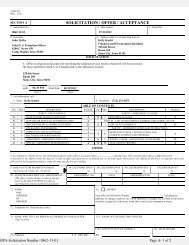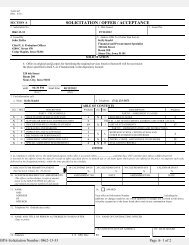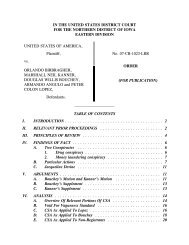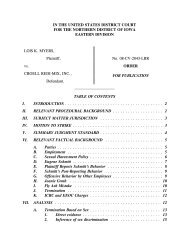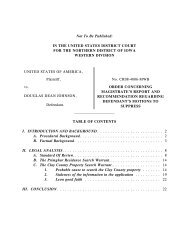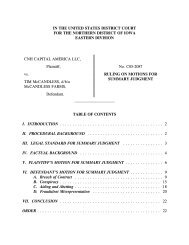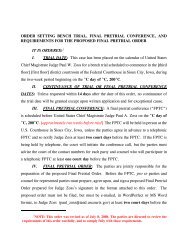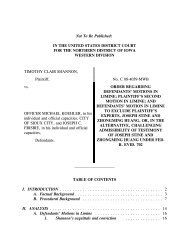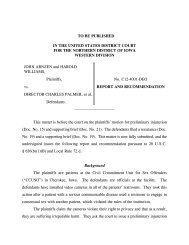To Be Published - Northern District of Iowa
To Be Published - Northern District of Iowa
To Be Published - Northern District of Iowa
You also want an ePaper? Increase the reach of your titles
YUMPU automatically turns print PDFs into web optimized ePapers that Google loves.
<strong>To</strong> <strong>Be</strong> <strong>Published</strong>:<br />
IN THE UNITED STATES DISTRICT COURT<br />
FOR THE NORTHERN DISTRICT OF IOWA<br />
CENTRAL DIVISION<br />
WILLIAM E. BABER,<br />
vs.<br />
Plaintiff,<br />
FIRST REPUBLIC GROUP, L.L.C.,<br />
and EVAN PARKS,<br />
Defendants.<br />
No. C 06-3076-MWB<br />
MEMORANDUM OPINION AND<br />
ORDER REGARDING<br />
DEFENDANTS’ MOTION TO<br />
COMPEL ARBITRATION AND TO<br />
STAY PROCEEDINGS<br />
____________________<br />
In this action, originally filed in the <strong>Iowa</strong> <strong>District</strong> Court for Webster County on or<br />
about October 20, 2006, plaintiff William E. Baber asserts various claims against<br />
defendant First Republic Group, L.L.C. (First Republic), a so-called “introducing broker”<br />
with which Baber had opened a securities brokerage account, and Evan Parks, an account<br />
executive for First Republic, based on allegedly improper overcharges totaling $147,021,<br />
resulting from marking up or marking down the price <strong>of</strong> stocks traded by Baber and<br />
diverting the difference between the stock price and the marked-up or marked-down price<br />
to the defendants. Baber’s specific claims are the following: common-law fraud in<br />
Count I; violation <strong>of</strong> the <strong>Iowa</strong> Securities Act in Count II; breach <strong>of</strong> contract in Count III<br />
(against First Republic only); breach <strong>of</strong> the covenant <strong>of</strong> good faith and fair dealing in<br />
Count IV (against First Republic only); breach <strong>of</strong> fiduciary duty in Count V; and<br />
misappropriation and/or theft <strong>of</strong> funds in Count VI. The defendants removed this action<br />
to this federal court on November 17, 2006, alleging diversity jurisdiction.
In lieu <strong>of</strong> answering Baber’s Complaint, the defendants filed on December 27,<br />
2006, the Motion <strong>To</strong> Compel Arbitration And <strong>To</strong> Stay Proceedings (docket no. 7) now<br />
before the court. In their motion and supporting brief, the defendants argue that they are<br />
entitled to compel arbitration <strong>of</strong> Baber’s disputes with them pursuant to an arbitration<br />
clause in an agreement between Baber and BNY Clearing Services, L.L.C. (BNY), a socalled<br />
“clearing broker,” which was actually responsible for administering Baber’s<br />
brokerage account with First Republic, because First Republic and Parks are, as a matter<br />
<strong>of</strong> circuit law, agents <strong>of</strong> BNY and third-party beneficiaries <strong>of</strong> the agreement between Baber<br />
and BNY. In support <strong>of</strong> this contention, the defendants cite Nesslage v. York Securities,<br />
823 F.2d 231 (8th Cir. 1987). They also contend that Baber is obligated to arbitrate his<br />
1<br />
disputes, because BNY is an indispensable party to this dispute. Therefore, they seek an<br />
order compelling arbitration and staying proceedings pending completion <strong>of</strong> arbitration.<br />
Baber resists on the ground that the Nesslage decision upon which the defendants rely<br />
states only certain fact-driven exceptions to the general rule that “introducing brokers” and<br />
their account representatives are not agents <strong>of</strong> “clearing brokers” nor third-party<br />
beneficiaries <strong>of</strong> a customer’s agreement with a “clearing broker.” Baber also contends that<br />
BNY is not an indispensable party, because his claims against First Republic and Parks are<br />
independent <strong>of</strong> any claim he may have against BNY and because complete relief, without<br />
possibility <strong>of</strong> inconsistency, can be granted in this case against the present defendants<br />
alone.<br />
1<br />
The defendants also argue, in passing, that Baber has failed to plead fraud with the<br />
particularity required by Rule 9(b) <strong>of</strong> the Federal Rules <strong>of</strong> Civil Procedure. However, the<br />
defendants did not frame their motion as a Rule 12(b)(6) motion to dismiss for failure to<br />
state a claim upon which relief can be granted, so that the court does not believe that such<br />
a contention is properly before it on a motion to compel arbitration.<br />
2
The court begins its analysis <strong>of</strong> the defendants’ contentions with an examination <strong>of</strong><br />
precisely what the Nesslage decision holds. In Nesslage, the district court granted in part<br />
and denied in part a motion to compel arbitration by a stock brokerage firm, York<br />
Securities, which was an “introducing broker” like First Republic here, and its registered<br />
account representative, Samson, <strong>of</strong> claims against them by investors, the Nesslages, based<br />
on alleged mishandling <strong>of</strong> the Nesslages’ account. Nesslage, 823 F.2d at 232. The district<br />
court found, inter alia, that the Nesslages, York Securities, and Samson intended that a<br />
margin agreement between the Nesslages and a clearing broker, Q & R Clearing<br />
Corporation, which included an arbitration provision, would govern their brokerage<br />
relationship, even though York Securities and Samson were not parties to the margin<br />
agreement, and that York Securities and Samson could, therefore, enforce the margin<br />
agreement and its arbitration provisions. Id. at 233. Although the district court granted<br />
the defendants’ motion to compel arbitration on several claims, the court determined that<br />
the Nesslages’ federal securities claim was not arbitrable, and the defendants appealed<br />
denial <strong>of</strong> arbitration on that claim. Id. at 232.<br />
The part <strong>of</strong> the Nesslage decision upon which the defendants here rely is a model<br />
<strong>of</strong> conciseness, but not necessarily a model <strong>of</strong> clarity. It states the following:<br />
The Nesslages argue the district court erred in finding<br />
that York Securities and Samson could enforce the margin<br />
agreement and its arbitration provision against them. The<br />
Nesslages argue that because York Securities and Samson were<br />
not parties to the margin agreement, they did not agree with<br />
York Securities and Samson to arbitrate their disputes and thus<br />
had no duty to arbitrate. See United Steelworkers v. Warrior<br />
& Gulf Navigation Co., 363 U.S. 574, 582, 80 S. Ct. 1347,<br />
1352, 4 L. Ed. 2d 1409 (1960). We hold the district court<br />
correctly determined that York Securities and Samson could<br />
enforce the margin agreement, and the arbitration provision<br />
3
contained therein, against the Nesslages, even though York<br />
and Samson were not parties to the margin agreement. York<br />
Securities and Samson were third-party beneficiaries <strong>of</strong> the<br />
margin agreement between the Nesslages and Q & R Clearing<br />
Corp.; York Securities was the disclosed agent <strong>of</strong> Q & R<br />
Clearing Corp., the clearing broker. See Okcuoglu v. Hess,<br />
Grant & Co., 580 F. Supp. 749, 750-52 (E.D. Pa. 1984); cf.<br />
Cauble v. Mabon Nugent & Co., 594 F. Supp. 985, 990-92<br />
(S.D.N.Y. 1984) (holding that trading broker could enforce<br />
agreement between its customer and clearing broker). But see<br />
Ahn v. Rooney, Pace Inc., 624 F. Supp. 368, 370 (S.D.N.Y.<br />
1985) (holding that introducing broker could not enforce<br />
agreement between customer and clearing broker).<br />
Nesslage, 823 F.2d at 233-34.<br />
Although not necessarily a model <strong>of</strong> clarity, this court cannot read the decision in<br />
Nesslage to stand for the proposition that all “introducing brokers” and their agents are,<br />
as a matter <strong>of</strong> law, agents <strong>of</strong> “clearing brokers” handling a customer’s securities or that<br />
all “introducing brokers” and their agents are, as a matter <strong>of</strong> law, third-party beneficiaries<br />
<strong>of</strong> an agreement, including any arbitration provision, between a customer and the “clearing<br />
broker,” as the defendants here contend. Rather, the only reasonable reading <strong>of</strong> the<br />
decision in Nesslage is that it was a fact-based decision that relied on fact-based<br />
authorities.<br />
More specifically, in Nesslage, the appellate court noted that the district court had<br />
made a fact-based determination that the Nesslages, York Securities, and Samson intended<br />
that a margin agreement between the Nesslages and Q & R Clearing Corporation, which<br />
included an arbitration provision, would govern their brokerage relationship, even though<br />
York Securities and Samson were not parties to the margin agreement, and that York<br />
Securities and Samson could enforce the margin agreement on the basis <strong>of</strong> that intention.<br />
Id. at 233. The appellate court then held that “the district court correctly determined that<br />
4
York Securities and Samson could enforce the margin agreement, and the arbitration<br />
provision contained therein, against the Nesslages, even though York and Samson were<br />
not parties to the margin agreement.” Id. The appellate court did not state that it was<br />
affirming the district court’s determination, but on different grounds and as a matter <strong>of</strong><br />
law; rather, the appellate court simply affirmed the district court’s determination. Id.<br />
Moreover, in explaining, further, that the introducing broker and its agent were<br />
agents <strong>of</strong> the clearing broker and third-party beneficiaries <strong>of</strong> the agreement between the<br />
customer and the clearing broker, the appellate court relied on three fact-driven cases, two<br />
finding that an introducing broker could enforce an agreement between a customer and a<br />
clearing broker and one finding that the introducing broker could not enforce such an<br />
agreement. In Okcuoglu v. Hess, Grant & Co., 580 F. Supp. 749 (E.D. Pa. 1984), the<br />
first decision relied on by the court in Nesslage, the district court stated that whether the<br />
parties had an agreement to arbitrate “‘depends upon the intent <strong>of</strong> the parties as it appears<br />
from the language used, its context within the instrument, and the circumstances<br />
surrounding its formation and execution.’” Okcuoglu, 580 F. Supp. at 750 (quoting Bruno<br />
v. Pepperidge Farm, Inc., 256 F. Supp. 865, 868 (E.D. Pa. 1966)). The court noted that,<br />
“[e]ssentially, the court must determine whether there was a clear meeting <strong>of</strong> the minds<br />
on the issue,” and that the “lynchpin <strong>of</strong> the analysis” was “whether the facts and<br />
circumstances surrounding the formation and execution <strong>of</strong> the document demonstrate that<br />
there was mutual assent to arbitration.” Id. The court found that the customer agreement<br />
between the investor and the clearing broker, which contained an arbitration clause, was<br />
not signed by the introducing broker’s representatives, but nevertheless, “unquestionably,<br />
by their conduct all parties adopted the terms there<strong>of</strong> governing the relationships.” Id.<br />
Furthermore, the court explained,<br />
5
After review <strong>of</strong> the evidence presented, the court<br />
concludes and agrees with Hess Grant [the introducing broker]<br />
that, under the Pershing option agreement, it was Pershing’s<br />
[the clearing broker’s] corresponding firm and agent for all<br />
plaintiffs’ options transactions. As introducing broker, Hess<br />
Grant was agent both to plaintiff and Pershing. Although<br />
plaintiffs have not sued Pershing, the transactions in question<br />
flowed or were to flow through that firm. The above<br />
enumerated options transactions cannot be said to exclude<br />
Pershings’ clearing or execution activity in plaintiffs’ accounts.<br />
It is yet possible that Pershing might be brought into the<br />
subsisting disputes as a necessary party. So long as that<br />
possibility exists, Pershing has the right to have any and all<br />
disputes as to options transactions it handled submitted to<br />
arbitration, including those between introducing broker and<br />
customer occurring during the period <strong>of</strong> its clearing agency<br />
agreement. In addition, by approving plaintiffs for options<br />
trading through Pershing, Hess Grant acted as a disclosed<br />
agent for Pershing. It follows that the arbitration provision in<br />
the Pershing Customer Agreement was applicable to options<br />
transactions disputes arising between plaintiffs and Hess Grant<br />
as Pershing’s agent. Mr. Okcuoglu had a clear understanding<br />
that any dispute involving Pershing, directly or indirectly,<br />
would be subject to arbitration. Accordingly, as to Counts I<br />
through VI, defendants’ motion to stay proceedings pending<br />
arbitration is granted.<br />
Okcuoglu, 580 F. Supp. at 751-52. Thus, the decision in Okcuoglu turned on fact-based<br />
determinations <strong>of</strong> the parties’ intent and the actual relationships between the introducing<br />
broker, the clearing broker, and the investors to determine that the introducing broker was<br />
the agent <strong>of</strong> the clearing broker.<br />
The decision in Cauble v. Mabon Nugent & Co., 594 F. Supp. 985 (S.D.N.Y.<br />
1984), applied an equally fact-driven analysis to the question <strong>of</strong> whether an introducing<br />
6
oker was the third-party beneficiary <strong>of</strong> a contract between a customer and a clearing<br />
broker;<br />
A third party may sue as a beneficiary to a contract if<br />
the parties intended their performance to benefit the third<br />
party. Port Chester Electrical Construction Corp. v. Atlas, 40<br />
N.Y.2d 652, 655, 357 N.E.2d 983, 985-86, 389 N.Y.S.2d<br />
327, 330 (1976). The Restatement Second <strong>of</strong> Contracts takes<br />
the position that, “unless otherwise agreed,” if “recognition <strong>of</strong><br />
a right to performance in the beneficiary is appropriate to<br />
effectuate the intention <strong>of</strong> the parties,” the beneficiary will be<br />
protected when “the circumstances indicate that the promissee<br />
intends to give the beneficiary the benefit <strong>of</strong> the promised<br />
performance.” Restatement (Second) <strong>of</strong> Contracts § 302. The<br />
customer agreement does not explicitly grant or deny Mabon<br />
a right to enforce any <strong>of</strong> its terms. The manner in which<br />
Cauble’s trading account was handled, however, demonstrates<br />
that performance <strong>of</strong> Cauble’s contractual obligations under the<br />
Goodman customer agreement was to be monitored and<br />
controlled by Mabon. At the time <strong>of</strong> the agreement’s<br />
execution, Cauble and Goodman were both aware <strong>of</strong> Mabon’s<br />
control <strong>of</strong> the functioning <strong>of</strong> Cauble’s account. Leon Pollack’s<br />
letter to Cauble on April 20, 1982 delineated the basic terms<br />
<strong>of</strong> the relationship between Cauble and Mabon. Mabon was to<br />
have supervisory powers over the Cauble account-including<br />
authority to collect margins for Goodman-and to have direct,<br />
daily contact with Cauble, while Goodman was to do no more<br />
than clear trades. Where performance is to be rendered<br />
directly to a third party under the terms <strong>of</strong> an agreement, that<br />
party must be considered an intended beneficiary. See<br />
Goodman-Marks Associates, Inc. v. Westbury Post Associates,<br />
70 A.D.2d 145, 148, 420 N.Y.S.2d 26, 28-29 (2d Dep’t 1979)<br />
(per curiam).<br />
If Mabon was an intended beneficiary <strong>of</strong> those terms <strong>of</strong><br />
the customer agreement governing the management <strong>of</strong> property<br />
in the customer account and margin calls, it should also be<br />
regarded an intended beneficiary <strong>of</strong> the liquidation provision.<br />
7
Goodman, in relying on Mabon for collecting margin<br />
payments, had a clear interest in providing Mabon with the<br />
power to make margin calls on Cauble and to otherwise<br />
determine whether any shortfall in margin payments merited<br />
liquidation. Mabon’s interest in having the power to liquidate<br />
is even more obvious; any loss due to delayed liquidation <strong>of</strong><br />
Cauble’s account might well have ultimately fallen on Mabon,<br />
because <strong>of</strong> its separate obligations to Goodman. In light <strong>of</strong><br />
Mabon’s central position in the Cauble/Mabon/Goodman<br />
relationship, Mabon should be recognized as a third party<br />
beneficiary <strong>of</strong> Goodman’s customer agreement, including the<br />
right to liquidate Cauble’s account, without demand or notice,<br />
for failure to maintain adequate margin. See Okcuoglu v.<br />
Hess, Grant & Co., Inc., 580 F. Supp. 749, 751-52 (E.D.<br />
Pa.1984) (broker managing account may rely on arbitration<br />
clause in customer’s agreement with clearing house).<br />
Cauble, 594 F. Supp. at 991-92 (emphasis added).<br />
Neither Okcuoglu nor Cauble states or stands for a black-letter legal rule that<br />
introducing brokers are agents <strong>of</strong> clearing brokers or third-party beneficiaries <strong>of</strong> contracts<br />
between clearing brokers and customers, and in citing those decisions in support <strong>of</strong> its<br />
conclusion in Nesslage, the Eighth Circuit Court <strong>of</strong> Appeals certainly did not imply that<br />
there is such a black-letter rule. The third decision cited by the Eighth Circuit Court <strong>of</strong><br />
Appeals in Nesslage for a contrasting result confirms that the determinations <strong>of</strong> agent and<br />
third-party beneficiary status are fact-driven. See Ahn v. Rooney, Pace, Inc., 624 F. Supp.<br />
368, 370-71 (S.D.N.Y. 1985) (distinguishing Okcuoglu and Cauble on the ground that<br />
those cases involved particular types <strong>of</strong> brokerage transactions, but further concluding that,<br />
even were such a distinction unavailable, the court would reach a different conclusion<br />
based on lack <strong>of</strong> evidence that the introducing broker and clearing broker were anything<br />
but entirely independent entities and the lack <strong>of</strong> evidence <strong>of</strong> consent by a principal that the<br />
other act on its behalf, and the relationship <strong>of</strong> the parties was insufficient to demonstrate<br />
8
a third-party beneficiary situation). In short, there is no black-letter rule in this Circuit<br />
that introducing brokers are agents <strong>of</strong> clearing brokers or that introducing brokers are<br />
third-party beneficiaries <strong>of</strong> agreements between customers and clearing brokers. Instead,<br />
under the authority on which the defendants’ rely, the determination <strong>of</strong> an introducing<br />
broker’s ability to enforce the arbitration provisions <strong>of</strong> a customer’s agreement with a<br />
clearing broker is a fact-driven question.<br />
In the case now before this court, the defendants have submitted Baber’s agreement<br />
with BNY, the clearing broker, including the text <strong>of</strong> the arbitration clause, but they have<br />
pointed to nothing in the contract or the arbitration clause that states or necessarily<br />
suggests that the parties intended the arbitration agreement to govern the relationship<br />
among Baber, First Republic, Parks, and BNY. See Nesslage, 823 F.2d at 233 (affirming<br />
the district court’s determination that the Nesslages, York Securities, and Samson intended<br />
that a margin agreement between the Nesslages and a clearing broker, Q & R Clearing<br />
Corporation, including the arbitration provision, would govern their brokerage<br />
relationship, even though York Securities and Samson were not parties to the margin<br />
agreement). Indeed, Baber has submitted an affidavit representing that he certainly had<br />
no such intent. See Plaintiff’s Resistance, Exhibit A, 6. The defendants have not<br />
submitted any agreement between First Republic and BNY demonstrating that those parties<br />
agreed that First Republic was BNY’s agent. Certainly, nothing in the record so far<br />
“discloses” First Republic or Parks as an agent <strong>of</strong> BNY. Compare Okcuoglu, 580 F.<br />
Supp. at 751-52 (the introducing broker was a “disclosed” agent <strong>of</strong> the clearing broker).<br />
Also, as Baber points out, the language defining the scope <strong>of</strong> the arbitration clause at issue<br />
here is different from the language defining the scope <strong>of</strong> the arbitration clause in Nesslage.<br />
In Nesslage, the court construed the arbitration clause to read, “‘[a]ny controversy arising<br />
out <strong>of</strong> or relating to [the account] . . . shall be settled by arbitration. . . .’” Nesslage, 823<br />
9
F.2d at 232 (quoting the contract with emendations by that court). Here, the arbitration<br />
clause is much narrower, providing not for arbitration <strong>of</strong> any controversy “arising out <strong>of</strong><br />
or relating to” the account in question, but only to “any claim, dispute or controversy<br />
between us or involving any affiliate <strong>of</strong> BNY Clearing Services, L.L.C.,” Defendants’<br />
Exhibit A, 25, so that a dispute between BNY and Baber, not a dispute between Baber<br />
and some other party concerning his account, falls within the scope <strong>of</strong> the arbitration<br />
provision. Thus, First Republic and Parks do not fall within the scope <strong>of</strong> entities who<br />
were necessarily intended as beneficiaries <strong>of</strong> the agreement.<br />
On the present record, the court concludes that the facts and circumstances do not<br />
establish that First Republic and Parks are agents <strong>of</strong> BNY or that they are third-party<br />
beneficiaries <strong>of</strong> the contract between BNY and Baber, such that they are entitled to enforce<br />
the arbitration clause in the BNY agreement. Under well-settled circuit law, the first step<br />
in analysis <strong>of</strong> whether or not a party may compel arbitration is whether a valid agreement<br />
to arbitration exists. See, e.g., Lipton-U. City, L.L.C. v. Shurgard Storage Ctrs., Inc.,<br />
454 F.3d 937 (8th Cir. 2006) (citing United Steelworkers <strong>of</strong> Am. v. Duluth Clinic, Ltd.,<br />
413 F.3d 786, 788 (8th Cir. 2005), in turn citing United Steelworkers <strong>of</strong> Am. v. Titan Tire<br />
Corp., 204 F.3d 858, 860 (8th Cir. 2000)). First Republic and Parks have failed to<br />
establish this first step, because First Republic and Parks are not parties to the agreement<br />
containing the arbitration clause.<br />
First Republic and Parks nevertheless argue that the court should compel arbitration,<br />
because BNY, a party to the arbitration agreement, is an indispensable party to this<br />
litigation. Rule 19(a) <strong>of</strong> the Federal Rules <strong>of</strong> Civil Procedure provides, in pertinent part,<br />
as follows:<br />
A person who is subject to service <strong>of</strong> process and whose<br />
joinder will not deprive the court <strong>of</strong> jurisdiction over the<br />
10
subject matter <strong>of</strong> the action shall be joined as a party in the<br />
action if (1) in the person’s absence complete relief cannot be<br />
accorded among those already parties, or (2) the person claims<br />
an interest relating to the subject <strong>of</strong> the action and is so<br />
situated that the disposition <strong>of</strong> the action in the person’s<br />
absence may (i) as a practical matter impair or impede the<br />
person’s ability to protect that interest or (ii) leave any <strong>of</strong> the<br />
persons already parties subject to a substantial risk <strong>of</strong> incurring<br />
double, multiple, or otherwise inconsistent obligations by<br />
reason <strong>of</strong> the claimed interest.<br />
FED. R. CIV. P. 19(a). As the Eighth Circuit Court <strong>of</strong> Appeals has explained, “Subsection<br />
‘(a)(1) requires joinder only when the absence <strong>of</strong> the unjoined party prevents complete<br />
relief among the current parties.... The focus is on relief between the parties and not on<br />
the speculative possibility <strong>of</strong> further litigation between a party and an absent person.’”<br />
Gwartz v. Jefferson Mem. Hosp. Ass’n, 23 F.3d 1426, 1428 (8th Cir. 1994) (quoting LLC<br />
Corp. v. Pension <strong>Be</strong>nefit Guar. Corp., 703 F.2d 301, 305 (8th Cir.1983)). Under<br />
subsection (a)(2), if the court determines, from a practical perspective, that a party may<br />
have an “interest” in the litigation, even though absent from it, then the question is<br />
whether that party’s interest will, as a practical matter, be impaired or impeded, or that<br />
an existing party may be subject to a substantial risk <strong>of</strong> incurring double, multiple, or<br />
otherwise inconsistent obligations. Id. at 1429.<br />
The defendants argue that BNY is an “indispensable” or “necessary” party, because<br />
it appears that Baber’s fraud claims are based on account notifications actually sent to<br />
Baber by BNY. On the present record, however, the court concludes that BNY is not a<br />
“necessary” or “indispensable” party within the meaning <strong>of</strong> Rule 19(a). As to subsection<br />
19(a)(1), as Baber points out, his claims are against First Republic and Parks, and relief<br />
can be accorded among the parties already present, even if there is some speculative<br />
possibility that he may eventually find it appropriate to pursue further litigation against<br />
11
BNY for its part in the fraudulent handling <strong>of</strong> his brokerage account. See id. at 1428.<br />
Thus, it appears that Baber’s contention is that BNY was merely acting as the agent <strong>of</strong><br />
First Republic and Parks in sending the notifications containing the fraudulent<br />
representations by First Republic and Parks. Assuming that BNY has an “interest” in this<br />
litigation, as required to be an indispensable party under subsection (a)(2), it is difficult<br />
to see how BNY’s interest would be impeded, where Baber claims here that First Republic<br />
and Parks, not BNY, are responsible for the improper handling <strong>of</strong> his account, and there<br />
is no realistic possibility that First Republic or Parks will be subject to incurring double,<br />
multiple, or otherwise inconsistent obligations, even if Baber also has a claim against<br />
BNY, because there is no showing that BNY would have a claim against First Republic<br />
or Parks that could result in double or multiple obligations.<br />
The defendants argue that Okcuoglu, 580 F. Supp. at 751-52, stands for the<br />
proposition that, so long as there is a possibility that BNY, the clearing broker, could be<br />
joined as a party, BNY’s right to compel arbitration <strong>of</strong> the present dispute is controlling.<br />
However, in Okcuoglu, the court concluded that the existing defendant, the introducing<br />
broker, was an agent <strong>of</strong> the clearing broker, and that the clearing broker could be joined<br />
as a necessary party. See id. Here, neither situation obtains, because the court concluded<br />
just above that BNY is not a necessary party and, further above, that there are no facts in<br />
the record at present demonstrating that First Republic or Parks was an agent <strong>of</strong> BNY.<br />
Thus, the possibility that BNY could be joined here, as a permissively joined party, is not<br />
enough to warrant compelling the parties already in this case to arbitration pursuant to an<br />
arbitration agreement to which the defendants are not parties.<br />
12
THEREFORE, the defendants’ December 27, 2006, Motion <strong>To</strong> Compel Arbitration<br />
And <strong>To</strong> Stay Proceedings (docket no. 7) is denied upon the present record.<br />
IT IS SO ORDERED.<br />
DATED this 21st day <strong>of</strong> February, 2007.<br />
__________________________________<br />
MARK W. BENNETT<br />
U. S. DISTRICT COURT JUDGE<br />
NORTHERN DISTRICT OF IOWA<br />
13



